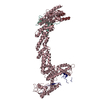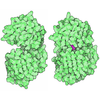+ Open data
Open data
- Basic information
Basic information
| Entry | Database: PDB / ID: 8k9i | |||||||||||||||
|---|---|---|---|---|---|---|---|---|---|---|---|---|---|---|---|---|
| Title | Structure of CUL3-RBX1-KLHL22 complex without CUL3 NA motif | |||||||||||||||
 Components Components |
| |||||||||||||||
 Keywords Keywords | LIGASE / Cullin Ring E3 ubiquitin ligase | |||||||||||||||
| Function / homology |  Function and homology information Function and homology informationpositive regulation of mitotic cell cycle phase transition / trophectodermal cellular morphogenesis / liver morphogenesis / POZ domain binding / nuclear protein quality control by the ubiquitin-proteasome system / polar microtubule / regulation protein catabolic process at postsynapse / COPII vesicle coating / anaphase-promoting complex-dependent catabolic process / cellular response to L-leucine ...positive regulation of mitotic cell cycle phase transition / trophectodermal cellular morphogenesis / liver morphogenesis / POZ domain binding / nuclear protein quality control by the ubiquitin-proteasome system / polar microtubule / regulation protein catabolic process at postsynapse / COPII vesicle coating / anaphase-promoting complex-dependent catabolic process / cellular response to L-leucine / cullin-RING-type E3 NEDD8 transferase / NEDD8 transferase activity / cullin-RING ubiquitin ligase complex / positive regulation of T cell mediated immune response to tumor cell / positive regulation of mitotic metaphase/anaphase transition / RHOBTB3 ATPase cycle / embryonic cleavage / Cul7-RING ubiquitin ligase complex / cell projection organization / ubiquitin-dependent protein catabolic process via the C-end degron rule pathway / cellular response to chemical stress / Loss of Function of FBXW7 in Cancer and NOTCH1 Signaling / positive regulation of protein autoubiquitination / RNA polymerase II transcription initiation surveillance / protein neddylation / Notch binding / fibroblast apoptotic process / NEDD8 ligase activity / RHOBTB1 GTPase cycle / negative regulation of response to oxidative stress / VCB complex / Cul5-RING ubiquitin ligase complex / SCF ubiquitin ligase complex / negative regulation of type I interferon production / ubiquitin-ubiquitin ligase activity / stem cell division / SCF-dependent proteasomal ubiquitin-dependent protein catabolic process / Cul2-RING ubiquitin ligase complex / mitotic metaphase chromosome alignment / Cul3-RING ubiquitin ligase complex / mitotic spindle assembly checkpoint signaling / Cul4A-RING E3 ubiquitin ligase complex / negative regulation of Rho protein signal transduction / Cul4-RING E3 ubiquitin ligase complex / stress fiber assembly / negative regulation of mitophagy / positive regulation of cytokinesis / Prolactin receptor signaling / Cul4B-RING E3 ubiquitin ligase complex / ubiquitin ligase complex scaffold activity / mitotic sister chromatid segregation / cullin family protein binding / protein monoubiquitination / endoplasmic reticulum to Golgi vesicle-mediated transport / sperm flagellum / RHOBTB2 GTPase cycle / ubiquitin-like ligase-substrate adaptor activity / protein K48-linked ubiquitination / protein autoubiquitination / intercellular bridge / Nuclear events stimulated by ALK signaling in cancer / gastrulation / 14-3-3 protein binding / transcription-coupled nucleotide-excision repair / positive regulation of TORC1 signaling / regulation of cellular response to insulin stimulus / negative regulation of insulin receptor signaling pathway / intrinsic apoptotic signaling pathway / negative regulation of autophagy / post-translational protein modification / cyclin binding / T cell activation / Regulation of BACH1 activity / positive regulation of protein ubiquitination / integrin-mediated signaling pathway / cellular response to amino acid stimulus / Degradation of DVL / kidney development / Degradation of GLI1 by the proteasome / GSK3B and BTRC:CUL1-mediated-degradation of NFE2L2 / Negative regulation of NOTCH4 signaling / G1/S transition of mitotic cell cycle / Recognition of DNA damage by PCNA-containing replication complex / negative regulation of canonical Wnt signaling pathway / Hedgehog 'on' state / Vif-mediated degradation of APOBEC3G / FBXL7 down-regulates AURKA during mitotic entry and in early mitosis / Degradation of GLI2 by the proteasome / GLI3 is processed to GLI3R by the proteasome / RING-type E3 ubiquitin transferase / protein destabilization / Degradation of beta-catenin by the destruction complex / positive regulation of T cell activation / DNA Damage Recognition in GG-NER / Oxygen-dependent proline hydroxylation of Hypoxia-inducible Factor Alpha / Evasion by RSV of host interferon responses / NOTCH1 Intracellular Domain Regulates Transcription / Dual Incision in GG-NER / Transcription-Coupled Nucleotide Excision Repair (TC-NER) / Constitutive Signaling by NOTCH1 PEST Domain Mutants Similarity search - Function | |||||||||||||||
| Biological species |  Homo sapiens (human) Homo sapiens (human) | |||||||||||||||
| Method | ELECTRON MICROSCOPY / single particle reconstruction / cryo EM / Resolution: 4.2 Å | |||||||||||||||
 Authors Authors | Wang, W. / Ling, L. / Dai, Z. / Zuo, P. / Yin, Y. | |||||||||||||||
| Funding support |  China, 4items China, 4items
| |||||||||||||||
 Citation Citation |  Journal: Nat Commun / Year: 2024 Journal: Nat Commun / Year: 2024Title: A conserved N-terminal motif of CUL3 contributes to assembly and E3 ligase activity of CRL3. Authors: Weize Wang / Ling Liang / Zonglin Dai / Peng Zuo / Shang Yu / Yishuo Lu / Dian Ding / Hongyi Chen / Hui Shan / Yan Jin / Youdong Mao / Yuxin Yin /  Abstract: The CUL3-RING E3 ubiquitin ligases (CRL3s) play an essential role in response to extracellular nutrition and stress stimuli. The ubiquitin ligase function of CRL3s is activated through dimerization. ...The CUL3-RING E3 ubiquitin ligases (CRL3s) play an essential role in response to extracellular nutrition and stress stimuli. The ubiquitin ligase function of CRL3s is activated through dimerization. However, how and why such a dimeric assembly is required for its ligase activity remains elusive. Here, we report the cryo-EM structure of the dimeric CRL3 complex and reveal a conserved N-terminal motif in CUL3 that contributes to the dimerization assembly and the E3 ligase activity of CRL3. We show that deletion of the CUL3 N-terminal motif impairs dimeric assembly and the E3 ligase activity of both CRL3 and several other CRL3s. In addition, we found that the dynamics of dimeric assembly of CRL3 generates a variable ubiquitination zone, potentially facilitating substrate recognition and ubiquitination. These findings demonstrate that a CUL3 N-terminal motif participates in the assembly process and provide insights into the assembly and activation of CRL3s. | |||||||||||||||
| History |
|
- Structure visualization
Structure visualization
| Structure viewer | Molecule:  Molmil Molmil Jmol/JSmol Jmol/JSmol |
|---|
- Downloads & links
Downloads & links
- Download
Download
| PDBx/mmCIF format |  8k9i.cif.gz 8k9i.cif.gz | 183.5 KB | Display |  PDBx/mmCIF format PDBx/mmCIF format |
|---|---|---|---|---|
| PDB format |  pdb8k9i.ent.gz pdb8k9i.ent.gz | 141.6 KB | Display |  PDB format PDB format |
| PDBx/mmJSON format |  8k9i.json.gz 8k9i.json.gz | Tree view |  PDBx/mmJSON format PDBx/mmJSON format | |
| Others |  Other downloads Other downloads |
-Validation report
| Summary document |  8k9i_validation.pdf.gz 8k9i_validation.pdf.gz | 1.3 MB | Display |  wwPDB validaton report wwPDB validaton report |
|---|---|---|---|---|
| Full document |  8k9i_full_validation.pdf.gz 8k9i_full_validation.pdf.gz | 1.3 MB | Display | |
| Data in XML |  8k9i_validation.xml.gz 8k9i_validation.xml.gz | 53 KB | Display | |
| Data in CIF |  8k9i_validation.cif.gz 8k9i_validation.cif.gz | 75.4 KB | Display | |
| Arichive directory |  https://data.pdbj.org/pub/pdb/validation_reports/k9/8k9i https://data.pdbj.org/pub/pdb/validation_reports/k9/8k9i ftp://data.pdbj.org/pub/pdb/validation_reports/k9/8k9i ftp://data.pdbj.org/pub/pdb/validation_reports/k9/8k9i | HTTPS FTP |
-Related structure data
| Related structure data |  36987MC  8k8tC M: map data used to model this data C: citing same article ( |
|---|---|
| Similar structure data | Similarity search - Function & homology  F&H Search F&H Search |
- Links
Links
- Assembly
Assembly
| Deposited unit | 
|
|---|---|
| 1 |
|
- Components
Components
| #1: Protein | Mass: 87432.312 Da / Num. of mol.: 1 Source method: isolated from a genetically manipulated source Source: (gene. exp.)  Homo sapiens (human) / Gene: CUL3 / Production host: Homo sapiens (human) / Gene: CUL3 / Production host:  | ||
|---|---|---|---|
| #2: Protein | Mass: 20365.340 Da / Num. of mol.: 2 Source method: isolated from a genetically manipulated source Source: (gene. exp.)  Homo sapiens (human) / Gene: KLHL22 / Production host: Homo sapiens (human) / Gene: KLHL22 / Production host:  #3: Protein | | Mass: 12289.977 Da / Num. of mol.: 1 Source method: isolated from a genetically manipulated source Source: (gene. exp.)  Homo sapiens (human) / Gene: RBX1, RNF75, ROC1 / Production host: Homo sapiens (human) / Gene: RBX1, RNF75, ROC1 / Production host:  |
-Experimental details
-Experiment
| Experiment | Method: ELECTRON MICROSCOPY |
|---|---|
| EM experiment | Aggregation state: PARTICLE / 3D reconstruction method: single particle reconstruction |
- Sample preparation
Sample preparation
| Component | Name: CUL3-RBX1-KLHL22 complex without CUL3 NA motif / Type: COMPLEX / Entity ID: all / Source: RECOMBINANT | ||||||||||||||||||||
|---|---|---|---|---|---|---|---|---|---|---|---|---|---|---|---|---|---|---|---|---|---|
| Source (natural) | Organism:  Homo sapiens (human) Homo sapiens (human) | ||||||||||||||||||||
| Source (recombinant) | Organism:  | ||||||||||||||||||||
| Buffer solution | pH: 7.5 | ||||||||||||||||||||
| Buffer component |
| ||||||||||||||||||||
| Specimen | Conc.: 2 mg/ml / Embedding applied: NO / Shadowing applied: NO / Staining applied: NO / Vitrification applied: YES | ||||||||||||||||||||
| Specimen support | Grid type: Quantifoil R1.2/1.3 | ||||||||||||||||||||
| Vitrification | Instrument: FEI VITROBOT MARK IV / Cryogen name: ETHANE / Humidity: 100 % / Chamber temperature: 277 K |
- Electron microscopy imaging
Electron microscopy imaging
| Experimental equipment |  Model: Titan Krios / Image courtesy: FEI Company |
|---|---|
| Microscopy | Model: FEI TITAN KRIOS |
| Electron gun | Electron source:  FIELD EMISSION GUN / Accelerating voltage: 300 kV / Illumination mode: FLOOD BEAM FIELD EMISSION GUN / Accelerating voltage: 300 kV / Illumination mode: FLOOD BEAM |
| Electron lens | Mode: DIFFRACTION / Nominal defocus max: 2000 nm / Nominal defocus min: 1500 nm |
| Image recording | Electron dose: 50 e/Å2 / Detector mode: SUPER-RESOLUTION / Film or detector model: GATAN K2 SUMMIT (4k x 4k) |
- Processing
Processing
| EM software |
| ||||||||||||||||||||||||
|---|---|---|---|---|---|---|---|---|---|---|---|---|---|---|---|---|---|---|---|---|---|---|---|---|---|
| CTF correction | Type: PHASE FLIPPING AND AMPLITUDE CORRECTION | ||||||||||||||||||||||||
| Particle selection | Num. of particles selected: 74279 | ||||||||||||||||||||||||
| 3D reconstruction | Resolution: 4.2 Å / Resolution method: FSC 0.143 CUT-OFF / Num. of particles: 74279 / Symmetry type: POINT |
 Movie
Movie Controller
Controller







 PDBj
PDBj








